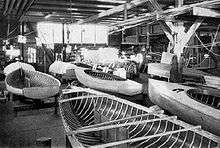Finn (dinghy)
|
Class symbol | |
 | |
| Boat | |
|---|---|
| Crew | 1 |
| Draft | 0.17 m (6.7 in) |
| Hull | |
| Hull weight | 107 kg (236 lb) |
| LOA | 4.5 m (14 ft 9 in) |
| LWL | 4.34 m (14 ft 3 in) |
| Beam | 1.47 m (4 ft 10 in) |
| Rig | |
| Mast Length | 6.66 m (21 ft 10 in) |
| Sails | |
| Mainsail area | 10.6 m2 (114 sq ft) |
| Misc | |
| D-PN | 90.1[1] |
| RYA PN | 1060[2] |
| Current Olympic Equipment | |

The Finn dinghy is the men's single-handed, cat-rigged Olympic class for sailing. It was designed by Swedish canoe designer, Rickard Sarby, in 1949 for the 1952 Summer Olympics in Helsinki. Since the 1952 debut of the boat, the design has been in every summer Olympics, making it one of the most prolific Olympic sailboats as it is the longest serving dinghy in the Olympic Regatta.[3] It currently fills the slot for the Heavyweight Dinghy at the Olympic games. It has been contended that the Finn is the most physical and tactical singlehander sailboat in the world.[4]
Design changes

Although the Finn hull has changed little since 1949, there have been developments to the rig. The original spars were made of wood until the late 1960s and early 1970s when there was a slow change to aluminum masts. Aluminum is significantly more flexible and gives more control over sail shape. It became commonplace after the 1972 Summer Olympics in Munich when they were first supplied to Olympic sailors. Recently, carbon fiber masts have become common place in competitive Finn fleets. The sails too have gone through revolution and are now commonly made of various laminates such as technora, polyester, and Kevlar. The class rules are overseen by the International Finn Association.
Events
Olympic Games
Finn Gold Cup
The Finn Gold Cup serves as the World Championship for the Finn class.
Continental Championships
References
- ↑ "Centerboard Classes". US Sailing. Retrieved 31 July 2012.
- ↑ "Portsmouth Number List 2012". Royal Yachting Association. Retrieved 31 July 2012.
- ↑ http://www.finnclass.org/the-finn/history-of-the-finn
- ↑ http://www.finnclass.org/the-finn/about-the-finn
External links
| Wikimedia Commons has media related to Finn (dinghy). |
- International Finn Association
- Russian Finn Association
- North American Finn Class for US and Canada
- Finn Site - Germany
- Finn BLOG - Argentina
- Finn Site - Argentina
- Finn Association Czech Republic
- ISAF Finn Microsite
- Hungarian Finn Class Association